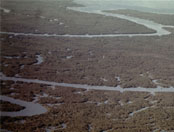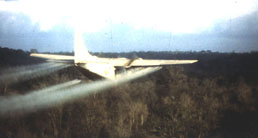Mangroves--
Most macrophytes are unable to survive in water that is not entirely fresh,
but one specialised group of plants – the mangroves – thrives in places
where salt and fresh water mix in and around river mouths. The physiological
adaptations that allow mangroves to tolerate salt need not concern us
here, but it seems that mangroves first evolved in tropical Asia and this
may account for the fact that there are more mangrove species (around
30) present in this region than anywhere else. Some of them reach 30 m
in height, while others are low and shrub-like. You should note that the
term 'mangrove' is used in two ways: it refers both to the individual
species (e.g., Rhizophora is a mangrove plant), and to the communities
of vegetation that the different species combine to form. Mangrove vegetation
(or forest) is present in the lower delta plain of the Mekong and on the
banks of the numerous small tidal channels. Most of the mangrove, however,
is situated in the tidal estuary southeast of Ho Chi Minh City with palm
swamps and marshes growing along the rearmost, landward fringe.
The family Rhizophoraceae is an important component of the mangrove
vegetation. The acidic mangrove soils contain little oxygen, and thus
some Rhizophoraceae have evolved special breathing roots (called pneumatophores)
that protrude above the surface of the mud to capture oxygen from the
air. In many species, the mangrove seeds germinate before they drop from
the parent tree and are ready to take root when they fall into the mud.
They are also able to float with the tide for extended periods until they
reach a suitable growing site.
The Mekong mangroves can be broadly divided into zones according to their
proximity to the sea:
a) The Avicennia-Sonneratia 'pioneer' zone at the seaward edge;
b) The Rhizophora zone;
c) The Brugieria-Kandelia-Ceriops zone;
d) The Lumnitzera-Xylocarpus-Bruguiera zone furthest from the sea.
The pioneering genus, Sonneratia, establishes itself at and above the low tide level. It is extremely tolerant of salt water and can withstand almost continuous inundation. The Sonneratia creates a seaward wall and its web-like root system traps silt, creating a firmer and drier environment that allows species of Rhizophora to colonize. In turn, species of Bruguiera establish themselves higher up the shore, where their roots are flooded by salt water only during the highest tides. In short, the zonation of mangroves on the shoreline reflects the tolerance of different species for inundation and salt water. In addition to the plants characterizing the four mangrove zones, species of the genera Acanthus, Aegiceras, Excoecaria and Heritiera are typical components of the forest. Moving inland, mangrove is replaced by the palm Nipa fructicans, which forms dense thickets along the edges of channels where the water is slightly salty. The large fern Acrostichum aureum, creepers such as Derris trifoliata, species of Pandanus (or Screw pine), Hibiscus tiliaceus, and other palms such as Phoenix paludosa that can grow in salty soils are present also. Further into the delta, where the intrusion of salt water lessens, swampy habitat dominated by Melaleuca leucadendron is encountered. This dominance reflects a long history of human disturbance of what was once diverse freshwater swamp forest.
 Mangrove
forests are highly productive environments and are important nursery or
spawning areas for shrimp, fish and other aquatic animals. They also support
a range of specialised molluscs and crustaceans that do not occur in other
habitats, as well as larger animals such as birds (pelicans, wader, etc.),
crocodiles (Crocodylus porosus) and monkeys (Macaca fascicularis).
The Mekong mangroves were severely damaged during 1960s and 1970s, when
about half of the original mangrove area in Viet Nam was destroyed through
aerial spraying of herbicides (including Agent Orange) by the American
military (Hatfield Consultants Ltd. and
Mangrove
forests are highly productive environments and are important nursery or
spawning areas for shrimp, fish and other aquatic animals. They also support
a range of specialised molluscs and crustaceans that do not occur in other
habitats, as well as larger animals such as birds (pelicans, wader, etc.),
crocodiles (Crocodylus porosus) and monkeys (Macaca fascicularis).
The Mekong mangroves were severely damaged during 1960s and 1970s, when
about half of the original mangrove area in Viet Nam was destroyed through
aerial spraying of herbicides (including Agent Orange) by the American
military (Hatfield Consultants Ltd. and  10-80
Committee, 1998 and 2000). The remains have been cleared at a rapid rate,
more quickly than other forests, and converted into aquaculture ponds
– mainly for culture of shrimps (especially Penaeus and Metapenaeus).
A Vietnamese government initiative in 1978 to plant mangrove forests has
led to the re-establishment of these forests in parts of the Mekong delta.
Plantations consist mainly of Rhizophora apiculata, but Rhizophora
mucronata and Kandelia candel have been planted also. In 1991,
one of these reforested areas (at Can Gio, 65 km south of Ho Chi Minh
City) was declared an 'Environmental Protection Forest' by the Council
of Ministers. Small plantations of Nipa have also been established,
as the leaves are used as building and thatching material.
10-80
Committee, 1998 and 2000). The remains have been cleared at a rapid rate,
more quickly than other forests, and converted into aquaculture ponds
– mainly for culture of shrimps (especially Penaeus and Metapenaeus).
A Vietnamese government initiative in 1978 to plant mangrove forests has
led to the re-establishment of these forests in parts of the Mekong delta.
Plantations consist mainly of Rhizophora apiculata, but Rhizophora
mucronata and Kandelia candel have been planted also. In 1991,
one of these reforested areas (at Can Gio, 65 km south of Ho Chi Minh
City) was declared an 'Environmental Protection Forest' by the Council
of Ministers. Small plantations of Nipa have also been established,
as the leaves are used as building and thatching material.